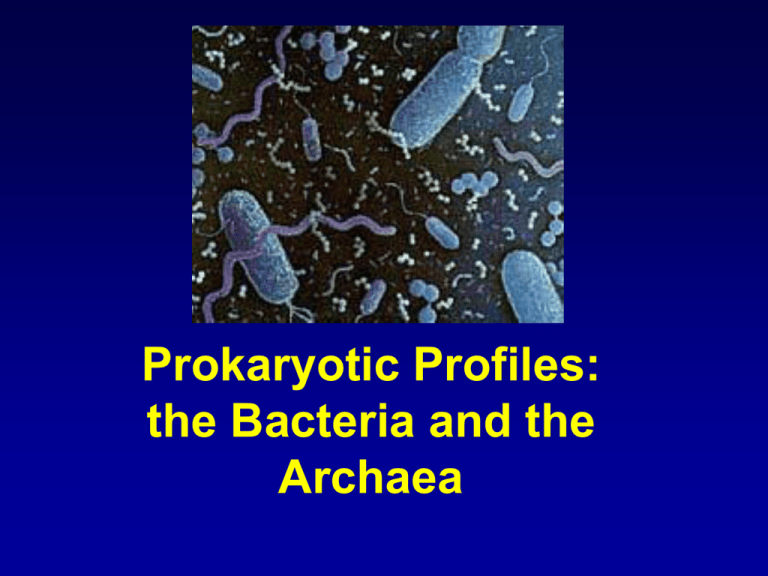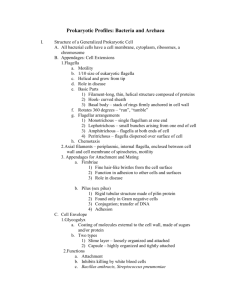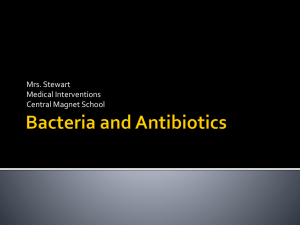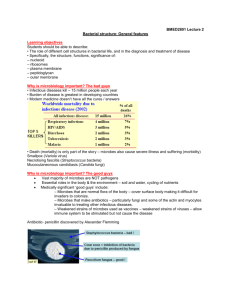Chapter 4 - eacfaculty.org
advertisement

Prokaryotic Profiles: the Bacteria and the Archaea Characteristics of Cells • Eucaryotic cells: animals, plants, fungi, and protists – contain membrane-bound nucleus with DNA as chromosomes – contain membrane-bound organelles that compartmentalize the cytoplasm and perform specific functions • Procaryotic cells: bacteria and archaea – no nucleus or other membrane-bound organelles 2 Prokaryotic Profiles 3 4 External Structures • Appendages – Two major groups of appendages: • Motility – flagella and axial filaments (periplasmic flagella) • Attachment or channels – fimbriae and pili • Glycocalyx – surface coating 5 Flagella • 3 parts – filament – long, thin, helical structure composed of proteins – hook- curved sheath – basal body – stack of rings firmly anchored in cell wall • Rotates 360o • 1-2, or many distributed over entire cell • Functions in motility 6 7 Flagellar Function Guide bacteria in a direction in response to external stimulus: chemical stimuli – chemotaxis; positive and negative light stimuli – phototaxis Signal sets flagella into rotary motion clockwise or counterclockwise: counterclockwise – results in smooth linear direction – run clockwise - tumbles 8 Chemotaxis in bacteria 9 Fimbrae • Fine hairlike bristles from the cell surface • Function in adhesion to other cells and surfaces 10 11 Pili • Rigid tubular structure made of pilin protein • Found only in Gram negative cells • Functions – joins bacterial cells for DNA transfer (conjugation) – adhesion 12 Conjugation 13 Glycocalyx • Coating of molecules external to the cell wall, made of sugars and/or proteins 2 types • 1. capsule - highly organized, tightly attached 2. slime layer - loosely organized and attached • Functions – – – Attachment and formation of biofilms inhibits killing by white blood cells protect cells from dehydration and nutrient loss 14 15 Biofilms 16 Biofilm on a Catheter 17 The Cell Envelope Composed of two basic layers: – cell wall and cell membrane • Maintains cell integrity • Two generally different groups of bacteria demonstrated by Gram stain: – Gram-positive bacteria: thick cell wall composed primarily of peptidoglycan and cell membrane – Gram-negative bacteria: outer cell membrane, thin peptidoglycan layer, and cell membrane 18 19 Peptidoglycan • Unique macromolecule composed of a repeating framework of long glycan chains cross-linked by short peptide fragments • Provides strong, flexible support to keep bacteria from bursting or collapsing because of changes in osmotic pressure 20 21 4 Bacterial Groups Based on Cell Wall Composition 1. 2. 3. 4. Gram positive cells Gram negative cells Bacteria without cell walls Bacteria with chemically unique cell walls 22 23 24 Gram Positive Cell Wall • Consists of – a thick, homogenous sheath of peptidoglycan 20-80 nm thick – tightly bound acidic polysaccharides, including teichoic acid and lipoteichoic acid – cell membrane • Retain crystal violet and stain purple 25 Gram Negative Cell Wall • Consists of – an outer membrane containing lipopolysaccharide (LPS) – thin shell of peptidoglycan – periplasmic space – inner membrane • Lose crystal violet and stain red from safranin counterstain 26 Cell Membrane Structure • Phospholipid bilayer with embedded proteins – fluid mosaic model • Functions in: – providing site for energy reactions, nutrient processing, and synthesis – transport into and out of the cell 27 Cell Membrane Structure 28 Cytoplasm • Dense gelatinous solution of sugars, amino acids, & salts • 70-80% water • serves as solvent for materials used in all cell functions 29 “Chromosome” • Single, circular, double-stranded DNA molecule that contains all the genetic information required by a cell • DNA is tightly coiled around protein, aggregated in a dense area called the nucleoid 30 Plasmids • • • • Small circular, double-stranded DNA Free or integrated into the chromosome Duplicated and passed on to offspring Not essential to bacterial growth & metabolism • May encode antibiotic resistance, tolerance to toxic metals, useful enzymes & toxins • Used in genetic engineering- readily manipulated & transferred from cell to cell 31 Ribosomes • Made of 60% ribosomal RNA & 40% protein • Consist of 2 subunits: large & small • Procaryotic differ from eucaryotic ribosomes in size, and number of proteins • Site of protein synthesis • All cells have ribosomes 32 Ribosomes 33 Endospores • Resting, dormant cells • Produced by some G+ genera: Clostridium, Bacillus & Sporosarcina • Have a 2-phase life cycle – vegetative cell & an endospore • Sporulation -formation of endospores • Germination- return to vegetative growth • Hardiest of all life forms • Withstand extremes in heat, drying, freezing, radiation & chemicals 34 Sporulation Cycle 35 Endospores • Environmental resistance linked to high levels of calcium & dipicolinic acid • Dehydrated, metabolically inactive • Thick coat • Longevity verges on immortality, 25-250 million years • Pressurized steam at 121oC for 20-30 minutes will destroy 36 3 Basic Shapes of Bacteria • Cocci - spherical • Bacilli - rod • Spiral - helical, comma, twisted rod, spirochete 37 38 Methods in Bacterial Identification 1. Microscopic morphology 2. Macroscopic morphology – colony appearance 3. Physiological / biochemical characteristics 4. Serological analysis 5. Genetic & molecular analysis • • • G + C base composition DNA analysis using genetic probes Nucleic acid sequencing & rRNA analysis 39 Major Taxonomic Groups of Bacteria • Domain Archaea – primitive, adapted to extreme habitats and modes of nutrition • Domain Bacteria – Phylum Proteobacteria – Gram-negative cell walls – Phylum Firmicutes – mainly Grampositive with low G + C content – Phylum Actinobacteria – Gram-positive with high G + C content 40 Bacterial Naming Conventions • species –a collection of bacterial cells which share an overall similar pattern of traits in contrast to other bacteria whose pattern differs significantly • strain or variety – a culture derived from a single parent that differs in structure or metabolism from other cultures of that species (biovars, morphovars) • type – a subspecies that can show differences in antigenic makeup (serotype or serovar), susceptibility to bacterial viruses (phage type) and in pathogenicity 41 (pathotype) Procaryotes with Unusual Characteristics Rickettsias • Very tiny, gram-negative bacteria • Most are pathogens that alternate between mammals and fleas, lice or ticks • Obligate intracellular pathogens • Cannot survive or multiply outside of a host cell • Cannot carry out metabolism on their own • Rickettsia rickettisii – Rocky Mountain spotted fever • Rickettsia prowazekii – epidemic typhus 43 • Coxiella burnetti – Q fever Chlamydias • • • • Tiny Obligate intracellular parasites Not transmitted by arthropods Chlamydia trachomatis – severe eye infection and one of the most common sexually transmitted diseases • Chlamydia psittaci – ornithosis, parrot fever • Chlamydia pneumoniae – lung 44 infections Mycoplasmas • Naturally lack a cell wall • Membranes stabilized by sterols, resistant to lysis • Extremely small • Range in shape from filamentous to coccus or doughnut shaped • Mycoplasma pneumoniae – causes atypical pneumonia in humans 45 Variations in the Shape of Mycoplasma pneumoniae 46 Free-living Nonpathogenic Bacteria • Photosynthetic bacteria – Cyanobacteria – Green & purple sulfur bacteria • Gliding, fruiting bacteria • Appendaged bacteria – produce an extended process of the cell wall in form of a bud, stalk or long thread 47 Archaea • Constitute third Domain • Appear more closely related to Domain Eucarya than to bacteria • Contain unique genetic sequences in their rRNA • Have unique membrane lipids & cell wall construction • Live in the most extreme habitats in nature, extremophiles • Includes: methane producers, hyperthermophiles, extreme halophiles, and 48 sulfur reducers











